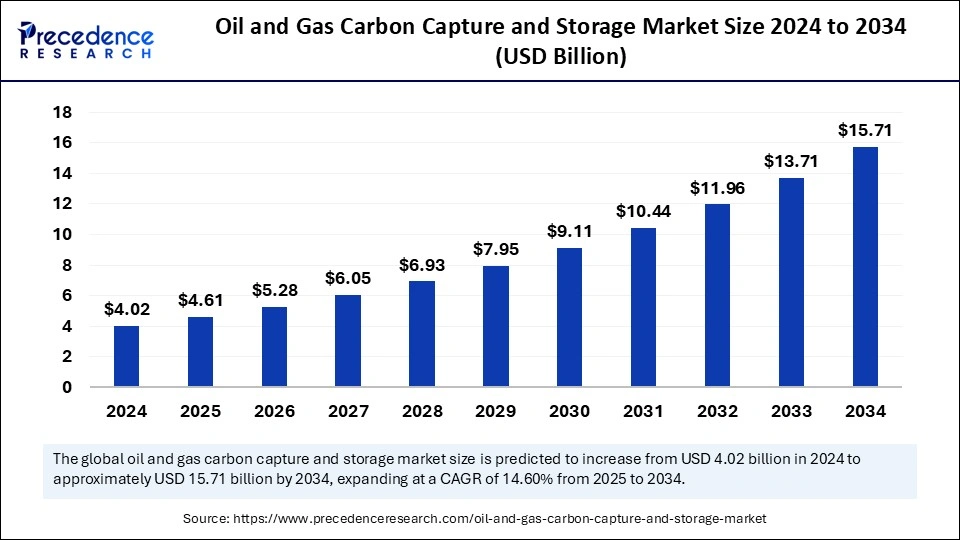Oil and gas carbon capture and storage market size is set to rise from USD 4.02 billion in 2024 to USD 15.71 billion by 2034, registering a strong CAGR of 14.60%.

Oil and Gas Carbon Capture and Storage Market Key Takeaways
- North America dominated the global market with the largest share of 36% in 2024.
- Asia Pacific is observed to expand at a rapid pace during the forecast period.
- By technology, the post-combustion segment accounted for the major market share of 50% in 2024.
- By technology, the pre-combustion segment is expected to grow at a significant of 18.1% during the forecast period.
Oil and Gas Carbon Capture and Storage Market Overview
The oil and gas carbon capture and storage market is at the forefront of the global effort to reduce carbon emissions from fossil fuel consumption. As the energy transition accelerates, CCS is emerging as a crucial technology that enables the industry to continue operations while aligning with global decarbonization goals. The market is experiencing renewed momentum, backed by climate agreements, net-zero pledges, and increasing investment in low-carbon technologies.
Oil and Gas Carbon Capture and Storage Market Drivers
Stringent environmental regulations and mounting societal pressure to decarbonize the oil and gas sector are key drivers for the CCS market. Governments are offering tax incentives, subsidies, and research grants to promote the adoption of CCS. Additionally, the scalability of CCS in large industrial applications, particularly in carbon-intensive refining and natural gas processing plants, makes it a strategic investment for long-term sustainability.
Increasing Environmental Concerns
The growing environmental concerns are driving the growth of the oil and gas carbon capture and storage market. Global warming is a major environmental concern around the world, resulting in the frequent occurrence of extreme weather events around the world. Carbon capture and storage (CCS) holds great potential to reduce greenhouse gas emissions from the oil and gas industry and their impact on climate change.
The adoption of carbon storage methods can significantly prolong the lifetime of existing oil and gas reservoirs by enhancing recovery and lowering the level of CO2 emitted during production. This approach can provide economic benefits for oil and gas companies and minimize their operations’ environmental impact. Thus, increasing efforts to lower CO2 emissions assist in achieving a low-carbon economy.
Oil and Gas Carbon Capture and Storage Market Opportunities
As carbon markets and climate financing grow globally, there is a strong opportunity to monetize carbon reductions through credit trading and green financing instruments. Offshore storage solutions, particularly in depleted oil and gas reservoirs, offer a viable and secure option for long-term CO₂ sequestration. International collaboration and knowledge sharing across energy producers are also expanding the commercial viability of CCS technologies in oil and gas.
Oil and Gas Carbon Capture and Storage Market Challenges
Cost remains a significant barrier in the oil and gas carbon capture and storage market, with many projects requiring substantial capital investment and long-term government support. Infrastructure limitations, such as the availability of CO₂ pipelines and suitable geological storage sites, can also slow deployment. Moreover, there is a knowledge gap in some regions regarding the technology’s benefits and implementation procedures, which affects stakeholder engagement.
Oil and Gas Carbon Capture and Storage Market Regional Insights
The United States is currently the most advanced market for oil and gas CCS, owing to favorable policy instruments like the 45Q tax credit and a mature carbon management ecosystem. Canada is also making strides with government-backed initiatives and pilot projects. In Europe, countries like Norway and the UK are developing offshore CCS hubs as part of broader carbon neutrality plans. Meanwhile, Asia is positioning itself as a future leader, with increased investment from national oil companies and state-run research programs.
Oil and Gas Carbon Capture and Storage Market Recent Developments
In recent developments, leading energy firms have announced multibillion-dollar CCS investments and joint ventures. Infrastructure projects focusing on carbon transport and offshore storage have gained traction. New regulatory frameworks supporting CCS have been introduced in several countries, while innovations in capture technologies are pushing down costs and improving carbon recovery rates. These trends indicate a maturing market with growing commercial interest and global collaboration.
Oil and Gas Carbon Capture and Storage Market Companies
- Air Products
- Chevron
- Exxon Mobil
- Dakota Gasification Company
- Equinor
- Mitsubishi Heavy Industries
- NRG Energy
- General Electric
- Halliburton
- Linde
- Shell
- Siemens
- SLB
- Sulzer
- TotalEnergies
Segments Covered in the Report
By Technology
- Pre Combustion
- Post Combustion
- Oxy-Fuel Combustion
By Region
- North America
- Asia Pacific
- Europe
- Latin America
- Middle East and Africa
Ready for more? Dive into the full experience on our website!